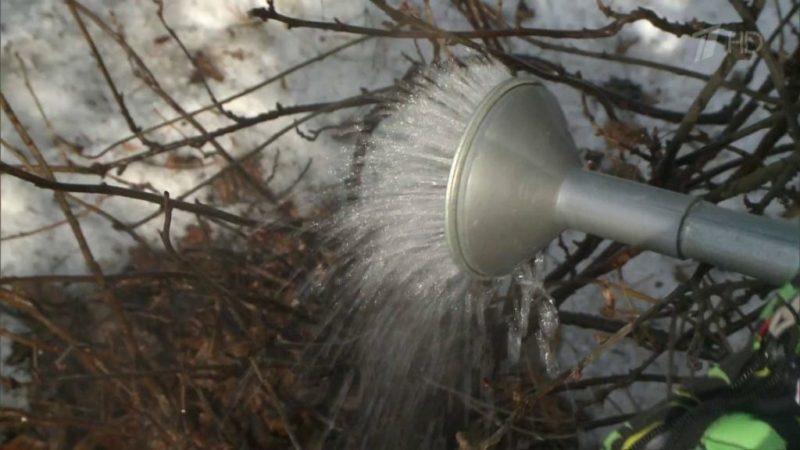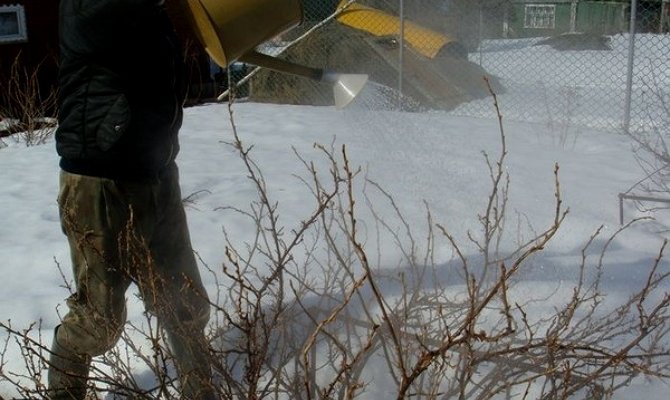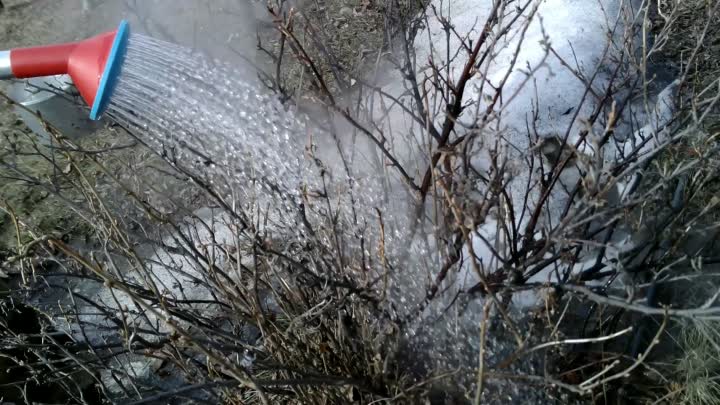Life hack for gardeners: how to properly pour boiling water over currants in spring and what it will give
Currant is an unpretentious garden shrub, undemanding to soil and maintenance. However, without due attention, it will produce fewer berries from year to year. One of the agrotechnical procedures required for a plant is spring watering with boiling water. Let's figure out how to properly pour boiling water over currants in spring and why to do it.
The content of the article
Why pour boiling water over currants in spring

Currant often becomes a winter refuge for various pests and their larvae. In the bark of a shrub, not only insects that are destructive for it can settle, but also pests of other garden crops. Hot water treatment leads to the folding of the protein of the larvae, and they die.
Important! Such treatment is especially important for the fight against the kidney currant mite, which settles in the buds and reduces the yield and growth of currants.
Also, such watering allows you to fight against fungal diseases, since the body of the fungus itself and its spores are extremely sensitive to temperature changes. Watering even with simple hot water with a temperature above + 40 ° C disrupts the natural processes of development of parasitic fungi.
Is it obligatory
The procedure is not strictly mandatory. Nevertheless, such treatment allows you to improve not only the bushes themselves, but also the area as a whole, while reducing the risk of the transition of winterized insects to awakening plants.
Advantages and disadvantages of watering

Watering currants with boiling water has many supporters and opponents. Despite the obvious advantages, the method does not protect the bush 100% and is not universal.
pros:
- destruction of insects, their pupae and larvae wintering in the buds and bark;
- reducing the risk of spreading fungal infections;
- increasing the general resistance of the shrub to diseases;
- an increase in the number of peduncles;
- general improvement of the site;
- environmental friendliness and simplicity of the method.
Minuses:
- spores of some fungi are resistant to this treatment;
- there is no protection against secondary infection;
- if care is not taken, there is a risk of scalding the plant;
- the risk of losing the crop if the procedure is violated.
The optimal timing when you need to pour the currants
Due to differences in climate, different duration of winter and weather conditions of the current year, the terms of the procedure not only differ in the regions, but also shift from year to year. If you water it too early, there is a risk of "waking up" the plant, and if you water it too late - scalding the awakening buds. Gardeners recommend focusing on the beginning of snow melting and an increase in daytime temperature to + 10 ° C.
Important! The main condition: the procedure is carried out before the onset of sap flow and the awakening of the kidneys.
Depending on the conditions of the past winter, the average terms of the procedure are as follows:
- Central Russia and Moscow Region - the first and second decades of March;
- Northern regions (Ural, northern part of Siberia) - the first and second decades of April;
- Southern Siberia - first decade of April;
- South - the first decade of March.
Weather
Based on the current weather conditions and the conditions of the past winter, gardeners are building a schedule of work, including watering currants. The vegetative processes of the shrub begin early: in the southern regions they can begin as early as the third decade of March, in the northern regions, Siberia and the Urals - in April. Therefore, it is necessary to water the plant with boiling water in advance.
The optimum daytime temperature for watering a plant ranges from +5 to + 10 ° C. Experienced gardeners do not recommend pouring boiling water immediately after the snow melts - then the risk of frost is still high, and because of this, the likelihood of early awakening of the shrub increases. It is best to perform the agrotechnical technique when the last snow lies.
Reference. In the northern regions, the snow can lie until May, sometimes until June, so this landmark is not the most correct when choosing the time of the procedure.
How to properly water currants

There are several processing methods: simple watering with boiling water, using boiling water with urea or potassium permanganate (potassium permanganate). In addition to the direct effect of hot water, additional disinfectants increase the effectiveness of the procedure as a whole.
The methods differ only in working solutions, the process itself is the same and consists in the following:
- The shrubs are examined, the shoots are tied in a bunch for better processing.
- The water is boiled, if necessary, additional components are introduced to the desired concentration.
- Boiling water is poured into a metal watering can with a fine-mesh nozzle. In contact with metal, the water will cool down to the desired temperature.
- Before watering, the water is additionally measured with a thermometer. The optimal indicator is + 60 ... + 80 ° С.
- The bushes are doused, directing the stream to the center of the plant and capturing all the shoots without exception.
- It should take no more than 5-7 seconds to process one bush, for large bushes - no more than 10 seconds.
- Additionally, soil is shed around the bush within a radius of 0.5 m.
If the roots protrude above the ground, they should be covered with any waterproof material so as not to burn.
Simple watering with boiling water
Watering with simple boiling water is not difficult. It is only important to observe the temperature limits and the distance from the watering can to the shrub - it should not be less than 10 cm, otherwise you can burn the branches.
Important! It is impossible to scald the bush a second time, even if some of the branches are missing.
Boiling water with urea

Urea (carbamide) not only helps in pest control, but also serves as an additional method of saturating the plant with nitrogen. Nitrogen is easily absorbed from the working solution by the kidneys and bark. In addition, urea slows down flowering and keeps the crop free from frost.
The working solution is prepared as follows:
- 10 liters of water;
- 50 g of copper sulfate;
- 0.5 kg of urea.
Boiling water with potassium permanganate
Potassium permanganate is one of the best remedies for fighting fungal infections. It destroys not only spores, but also the body of the fungus itself, increases the effectiveness of boiling water against many pests, for example, ticks.
Reference. If the soil is saturated with potassium, processing with potassium permanganate is highly undesirable.
The working solution is prepared from 10 liters of boiling water and 5 g of potassium permanganate. This amount is contained in one third of a teaspoon without top. Potassium permanganate is thoroughly stirred until the crystals are completely dissolved. Undissolved particles can cause plant burns, so dilution should be carefully monitored.
An alternative to watering - using a steam cleaner
There is an alternative method, which some gardeners consider to be fundamentally more convenient and safer, - using a steam cleaner... Hot steam under pressure has a similar effect on insects and fungi, but it is considered safer for the plant itself. Any steam generator can be used. The advantage of this treatment is that there is no need to boil a large amount of water and carry heavy watering cans. Steam also penetrates more actively into small cracks in the bark, where fungi and insects can settle, which generally increases the effectiveness of the procedure.
When carrying out a procedure using a steam cleaner, you need to know the temperature that it gives at the outlet. This is usually indicated in the instructions, but in the absence of data, you can use an ordinary thermometer to measure.The temperature of the steam falling on the shoots should be in the range from +60 to + 80 ° С.
It is interesting:
How and what to spray currants in the spring from pests and diseases
Step-by-step instructions on how to prune currants in the spring to have a good harvest
Conclusion
Watering with boiling water is an environmentally friendly and effective procedure for healing currant bushes. Of course, its effectiveness is significantly lower than that of chemical fungicides and insecticides. Efficiency can be increased by adding potassium permanganate or urea to boiling water. The method is suitable for gardeners who do not want to once again resort to chemical methods to protect fruit and berry crops from insects and fungal infections.